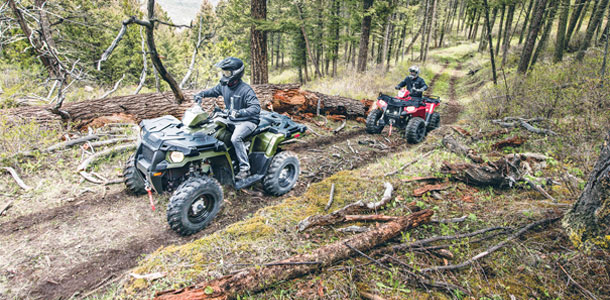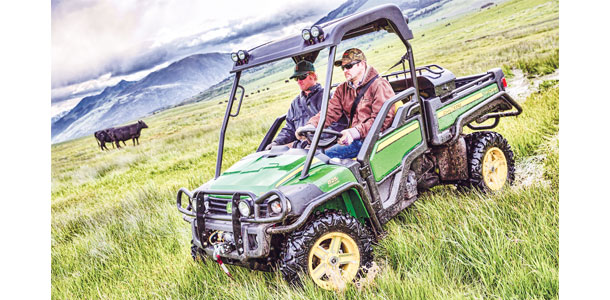Deaths reported from all-terrain vehicle mishaps dropped to 327 in 2011 from 590 in 2010, according to the Consumer Products Safety Commission.
Numbers have declined since 2005, but CPSC reports more than 107,000 emergency room-treated injuries from ATV accidents in 2011. Nearly 30 percent of those involved youngsters under 16 years old.
ATVs and utility vehicles (UTVs) have become important to many livestock operations. In fact, 86 percent of respondents to a reader survey said they use ATVs. Over time, these vehicles have become larger, more powerful, faster and capable of doing tasks never imagined.
“Because of their capabilities, ATVs and UTVs with high payloads, hauling and towing capabilities and pallet-sized dump boxes, can be used for a variety of ranching tasks such as hauling hay, grain, dirt and manure,” Donna Beadle, spokesperson for Polaris, Medina, Minnesota, says.
“Multi-passenger units can be used to move cattle hands around the ranch with capacity for up to six people. In fact, some ranchers use these vehicles, instead of horses, to gather and work cattle.”
With this wide range of use, experts recommend a focus on safety like never before.

Bill Harshman (pictured above) is a senior research associate with the agriculture and bioengineering department at Pennsylvania State University in University Park, Pennsylvania. He says that ATVs and UTVs on farms and ranches are generally used as workhorses, not recreational vehicles.

Additionally, ATVs and UTVs differ in that ATVs are rider-active, meaning drivers help steer with their bodies, and are more agile than UTVs. ATVs also don’t have the safety features UTVs offer.
“On the farm, these are used more as tools, and we tend to see fewer injuries and fatalities compared to recreational use,” Harshman says.
“They’re used to fix fence, check cattle, spray weeds and such and are operated at relatively slow speeds and often with intermittent use during the day. Like any equipment you work with, you tend to use it, not abuse it.”

He stresses that ATV and UTV familiarity on ranches should not breed complacency with safety protocols.
In fact, working around cattle, operating on uneven terrain and driving over sharp objects requires vigilance. A few safety specifics include:
- Helmets – A full-face helmet the correct size should be worn. Use sound judgment when working at tasks that require close inspection or low-speed work in high temperatures when helmets can become horribly hot. Reality may dictate not wearing a helmet at these times.
-
Face shields/goggles – Even at slow speeds, Harshman recommends eye protection, whether you use a face shield or a pair of goggles.
For example, if you’re trying to find a stray calf, especially in the woods, you’ll need some face protection,” he says. “One stray limb or thorn easily causes eye damage.” Other recommendations are: - Footwear – Wear boots or over-the-ankle shoes with good heel.
- Gloves/clothing – They should be determined by the task, but avoid loose-fitting clothes that can easily catch on branches or fences.
- Maintenance – Routinely check tires, brakes, lights, throttle, drive train, chassis, oil and fuel.
Valuable
Like any good ranch hand, ATVs and UTVs can earn their keep. Kevin Lund, product line marketing manager for utility vehicles at John Deere, Cary, North Carolina, says these vehicles are becoming increasingly valuable to ranchers.
“Because cattle operations are so labor-intensive, ATVs and UTVs are important,” he says. “Cattlemen use them every day – and not just for production activities.
It also includes landscaping around the house, hunting and even a trip to the favorite fishing hole.
“UTVs have become incrementally more valuable and have been widely adopted as they’ve evolved with larger cargo boxes, higher speeds and better safety features,” Lund adds.
“The number-one thing ranchers tell us they like about UTVs is the fact that they go everywhere.”
If you’re considering replacing an ATV or UTV, or buying a new one, Lund suggests truthfully assessing how you may use it.
“Seriously consider how you’re going to put a UTV to work,” he says. “Look at anything and everything you think you might need it for.
People often buy one for a few jobs, get it home and realize there’s a lot more to do. Next, understand the capabilities each model offers, such as cargo box size, speed capability, terrain capability, suspension systems and such.
Then buy at least the vehicle that fits these requirements and maybe a little more.
“Last, familiarize yourself with all the attachment and accessories available,” Lund adds.
Realizing the full value ATVs and UTVs can add to an operation means maintenance and safety remain at the forefront.
Lund, Beadle and Harshman concur that ATV users should follow the golden rules of ATV safety available from the ATV Safety Institute and that UTV users follow the safety rules of the Recreational Off-highway Vehicle Association. Both organizations offer training courses.
More information is available online at Safe Use of ATVs in Agriculture. ![]()
Rick Purnell is a freelance writer based in California.
PHOTOS
PHOTO 1: Nick Jindra of Jindra Angus in Clarkson, Nebraska makes a routine check of cattle in a remote pasture. Photo courtesy of David Cooper.
PHOTO 2: Bill Harshman, senior research associate, agriculture and bioengineering department, Pennsylvania State University.
PHOTO 3: Recreational uses remain a key reason for buying an ATV, but their work use on the ranch is expanding as well. Photo courtesy of Polaris.
PHOTO 4:Working an ATV around cattle in uneven terrain requires vigilance. Photo courtesy of John Deere
Help kids learn safety
About every three days, a child dies in an agriculture-related incident, according to the National Children’s Center for Rural and Agricultural Health and Safety.
Of the leading causes of youth fatalities, 25 percent involved machinery, 17 percent involved motor vehicles, including ATVs, and 16 percent were drownings.
If folks at the Progressive Agriculture Foundation had their way, farm injury rates would be dropping faster than they are.
The National Institute for Occupational Safety and Health reports there were 16.6 childhood injuries per 1,000 farms in 1998 and 6.4 in 2012.
For 20 years, PAF has organized Agriculture Safety Days to teach children about safety on topics ranging from ATVs to water safety.
The programs will reach 100,000 to 110,000 children and volunteer leaders this year in North America, the U.S. Virgin Islands and American Samoa.
“Of all the topics we offer, ATV safety is tops,” Bernard Geschke, program specialist, Papillon, Nebraska, says. “In 2013, 61 percent of our Safety Days had a program about ATVs. This tells us it’s the most important topic out there.
“When I first started 25 years ago, the number one cause of injuries and fatalities came from tractors,” Geschke says.
“ATVs have taken over that spot. More often, the injuries happen when the ATV is being used as a recreational vehicle instead of a work vehicle.”
Parental examples are key when it comes to safety. This includes ensuring an ATV is age-appropriate and not too large for kids to handle.
Without a doubt, Geschke says the primary piece of safety equipment is a helmet. The second-most important item to wear is goggles, followed by leather gloves, boots and long pants.
“If Mom and Dad don’t wear their helmets, kids will wonder why they should wear theirs,” he says. “The emphasis on safety has to come from parents. In our workshops, we empower them to say the most loving word: ‘No’.
“If we can do this, we’ll progress toward fulfilling our mission that no child becomes ill, injured or dies from farm, ranch or rural activities,” Geschke adds.
Visit Progressive Agriculture Safety Day to find a Safety Day in your area.

Bernard Geschke
program specialist
Progressive Agriculture Foundation.







